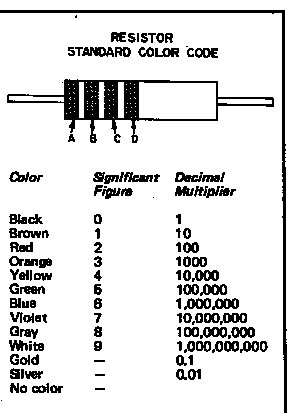Recognising resistors and capacitors.

Resistor Colour Coding
In most common resistors:
A = 1st figure of the value
B = 2nd figures of the value
C = Number of noughts to add (to make value in Ohms)
D = Tolerance
Gold: 5%, Silver: 10%, none: 20%
Yellow/Violet/Orange = 4700
47000 = 47K
(K is 000, M is 000,000)
Brown/Black/Orange/Gold
Is 10K (5%) etc.
The European designation is becoming common these days in which the multiplier (K or M) replaces the decimal point. i.e.
4700 ohms=4.7K ohms - written as 4K7 |
1M ohm as 1M0 |
51 ohms as 51R etc. |
Capacitor Markings and Values (µ and n etc.)
µ = microfarads, n = nanofarads, p = picafarads. The relationship is easy - the common ones are:
0.001uF = 1n9(=1000pF) |
0.01uF = 10n |
0.1uF = 100n |
There are a variety of (sometimes obscure) capacitor colour codings but the commonest markings on modern capacitors are:
Decade Markings:
A three number system where the third number is the number of noughts
after the first two - which are the base value.
101 = 100pF |
102 = 0.001uF (1n) |
103 = 0.01uF (10n) |
104 = 0.1uF (100n) |
- are the common ones but watch out for confusion:
203 = 0.02uF |
220 = 22pF |
221 = 220pF |
4R7 = 4.7pF - etc. |
J = 5% |
K = 10% |
M = 20% are the common ones, |
There may be a letter to indicate tolerance:
So 474J = 470000 = 0.47uF = 470n